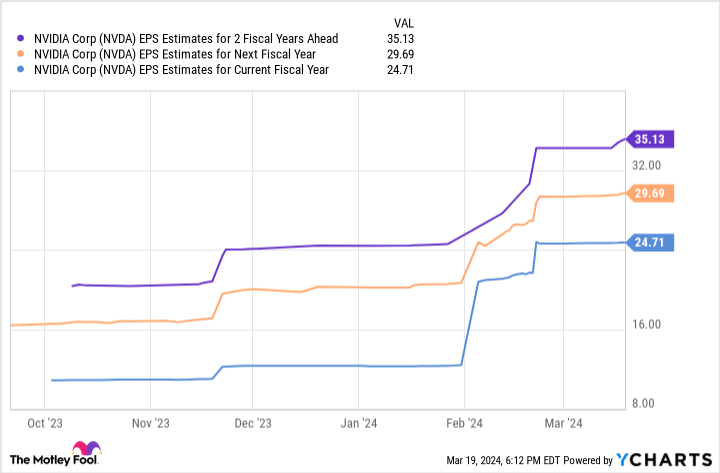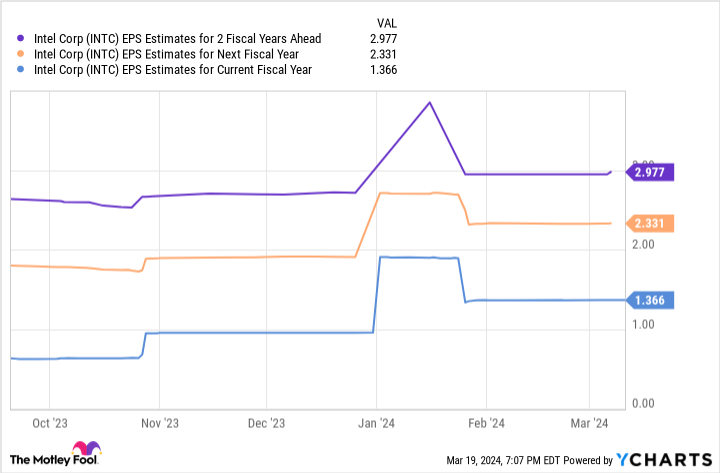Data from Statista shows the video games market was valued at close to $400 billion last year, and is projected to hit over $1 trillion by 2032. The industry has a long reputation for offering companies and their investors consistent gains over the long term thanks to reliable demand for new content and hardware upgrades.
An economic downturn in 2022 caused a dip in the video games market as spikes in inflation forced consumers to cut discretionary spending. However, market improvements have paved the way for a recovery over the last year, with countless tech stocks on the rise. As a result, it’s not a bad time to invest in the video games sector and profit from its development over the next decade.
Rapidly expanding markets like virtual/augmented reality (VR/AR) and artificial intelligence (AI) are bound to boost video game stocks in the coming years. So here are two gaming stocks to buy in March.
1. Nvidia
Nvidia‘s (NVDA 3.12%) business exploded last year as its chips became the gold standard for AI developers everywhere. The company’s stock is up 247% over the last year, almost entirely thanks to its success in the high-growth industry. However, long before its prominence in AI, Nvidia held a powerful position in gaming.
The company’s graphics processing units (GPUs) are popular among PC gamers, who use Nvidia’s hardware to build powerful gaming machines. Additionally, the tech giant designs semi-custom chips for one of the world’s most popular game consoles, the Nintendo Switch. Nvidia’s gaming segment posted revenue growth of 56% year over year in the fourth quarter of 2023, showing signs of recovery from the previous year’s economic downturn.
Nvidia chips power multiple areas of gaming, making its stock one of the best ways to invest in the industry. Meanwhile, its dominance in AI only strengthens its gaming potential, as it can offer video game companies access to immensely powerful hardware.
Data by YCharts
The above table shows Nvidia’s earnings could hit close to $35 per share by fiscal 2026. Multiplying that figure by its forward price-to-earnings ratio (P/E) of 36 yields a stock price of $1,252.
Considering the company’s current position, that projection would see Nvidia’s stock rise 41% over the next two years. Alongside a solid position in gaming, Nvidia is a screaming buy this month.
2. Intel
Intel (INTC 0.35%) isn’t best known for its gaming efforts. However, the company has had a stake in the industry for years, with its central processing units (CPUs) popular among PC gamers.
Gaming sales have seen Intel achieve a 62% market share in CPUs. Meanwhile, the company recently diversified its position in video games by launching its first-ever GPUs in 2023.
In Q4 2023, Intel’s client computing group segment (which includes gaming chip sales) posted revenue growth of 33% year over year, suggesting the business is moving in a positive direction. In addition to gaming, Intel’s venture into GPUs is promising for its growing prospects in AI.
Data by YCharts
This chart shows Intel’s earnings could reach just under $3 per share by fiscal 2026. In a similar calculation to the one we did with Nvidia, multiplying that figure by Intel’s forward P/E of 31 yields a stock price of $93.
If correct, these projections would see the tech giant’s stock rise 121% over the next two fiscal years, making Intel a no-brainer this month.
3. Microsoft
Microsoft (MSFT -0.15%) wasn’t always successful in video games. It released its first console, the Xbox, in 2001. Microsoft took a gamble by entering a highly competitive sector that Japanese companies like Nintendo and Sony had long dominated.
However, Microsoft has come a long way in the last 20 years. It’s now among the top four biggest public game companies by revenue as of the second quarter of 2023.
The tech giant hit a major milestone in its gaming journey in 2017 when it debuted Xbox Game Pass, a subscription-based service that offers members access to an extensive library of games for a small monthly fee. One of its biggest selling points is that subscribers can play brand-new Microsoft titles on day one of their releases at no extra charge.
From 2020 to 2024, the number of Game Pass members rose 250% to 34 million. The platform added significant value to Microsoft’s Xbox console, removing the need for consumers to pay individually for games, as was necessary on competing consoles. Moreover, Microsoft’s acquisition of Activision Blizzard last year will further boost Game Pass with its catalog of popular titles, such as Call of Duty and Overwatch.
Microsoft’s future is bright, making its shares a compelling option for anyone looking to invest in video games. Its forward P/E of 36 means its stock isn’t a bargain buy. However, its dominant position in gaming and tech, along with exciting prospects in AI, make it worth its high valuation — and worth buying right now.
Dani Cook has no position in any of the stocks mentioned. The Motley Fool has positions in and recommends Microsoft and Nvidia. The Motley Fool recommends Intel and Nintendo and recommends the following options: long January 2023 $57.50 calls on Intel, long January 2025 $45 calls on Intel, long January 2026 $395 calls on Microsoft, short January 2026 $405 calls on Microsoft, and short May 2024 $47 calls on Intel. The Motley Fool has a disclosure policy.



